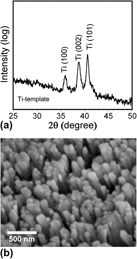Article contents
Hydrothermal BaTiO3 thin films from nanostructured Ti templates
Published online by Cambridge University Press: 02 March 2011
Abstract

Polycrystalline BaTiO3 thin films have been prepared by hydrothermal reaction with sputter-deposited nanostructured reactive Ti templates designed to control net diffusion direction and distance. Templates were prepared in two morphologies, i.e., planar and nanopillar. The samples produced from flat templates showed sluggish transformation kinetics and an eventual termination of reaction without fully consuming the Ti metal. Templates with pillar morphology, on the other hand, could be transformed to phase-pure BaTiO3, independent of the template thickness. In the as-precipitated state, those films revealed a permittivity of ~1000 and loss tangent values around 0.1 with mild dispersion in the kilohertz frequency range. Annealing these films under forming gas containing 1 vol% H2 balance N2 for 3 h at 200 °C decreased high-field losses to 0.06 and reduced dispersion. Mn incorporation as an in situ acceptor dopant was also explored. Addition of Mn during hydrothermal treatment further improved the electrical properties. Annealing under the same postgrowth conditions virtually eliminated the frequency dispersion in the range of 1 kHz to 1 MHz, while maintaining permittivity values in the range of 350.
Keywords
- Type
- Articles
- Information
- Copyright
- Copyright © Materials Research Society 2011
References
REFERENCES
- 3
- Cited by


